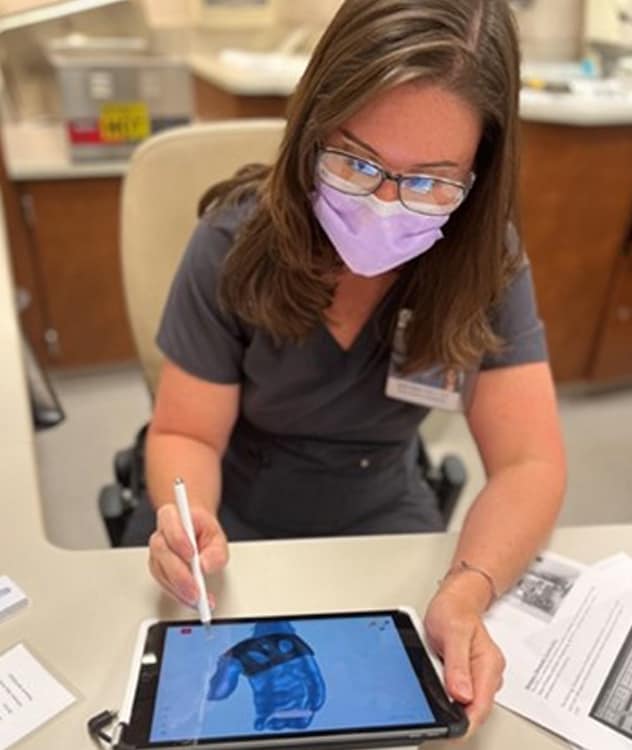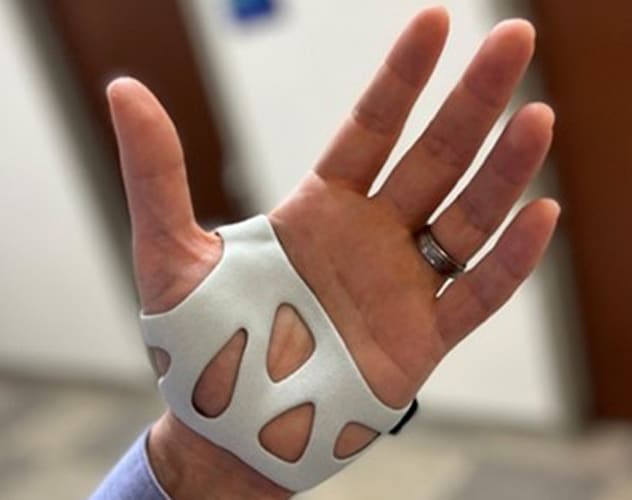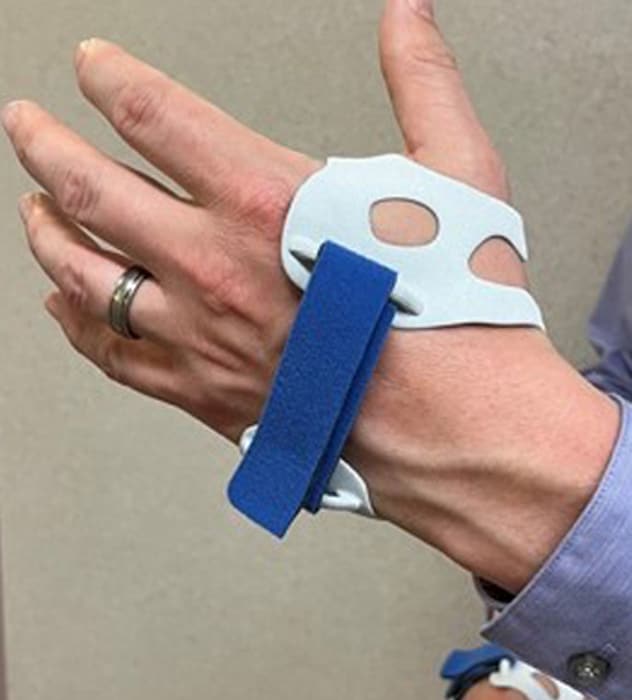Feb. 10, 2023
Designing orthoses such as casts, braces or splints that are rigid enough to keep the injured site immobilized and supported, while maintaining patient comfort and satisfaction, is an ongoing challenge. To meet this challenge, researchers and clinicians are testing the use of new materials and methods in the production of these devices. The application of 3D-printing technology to the construction of orthoses has provided some new options now available at Mayo Clinic.
Production process
Using the 3D-printing technology to produce orthoses for patients with a variety of fractures and joint disorders in the wrist and hand involves staff members from multiple disciplines within Mayo Clinic. Collaborators include staff members from the 3D Anatomical Modeling Laboratory, headed by radiologist Jonathan M. Morris, M.D., as well as staff from physical medicine and rehabilitation and orthopedics. The process begins when an occupational therapist scans the patient's injured arm using a tablet equipped with a camera. Within five minutes, the software turns the information obtained from that scan into a digital model of a splint or other form of brace.
Finalización del diseño y la órtesis

Finalización del diseño y la órtesis
Después de tomar imágenes de la extremidad lesionada del paciente mediante una tableta equipada con una cámara, un terapeuta ocupacional completa el diseño y la órtesis en la tableta antes de solicitar su impresión.
Órtesis terminada, palma

Órtesis terminada, palma
Una órtesis terminada, que muestra la palma de la mano.
Órtesis terminada, dorso

Órtesis terminada, dorso
Una órtesis terminada, que muestra el dorso de la mano.
According to Stephanie N. Kannas, C.H.T., O.T., O.T.D., an occupational therapist at Mayo Clinic's campus in Rochester, Minnesota, the patient doesn't need to be present after the scan. "We can finish the device design without them. Our staff are trained to clean up the live picture and place landmarks to help the computer program understand different key points of surface anatomy. We have the option of drawing the entire brace freehand, or we can enable artificial intelligence features that allow the software to design 100% of the device. We can rotate the patient's hand, or other limbs, in all different directions to produce what we want. And then we indicate what kind of materials we want to print in."
After the design phase is complete, the scan data is transferred into a printer, and the device is fabricated. Radiology staff members then handle the post-processing to ensure quality. Depending on the type of device being created, patients are asked to return to the clinic to check if any adjustments are needed. "Eventually, our goal will be to mail the completed orthosis to the patient within two days," says Dr. Kannas.
Benefits of the 3D-printed braces and splints
Traditional orthoses made of plaster, fiberglass or low-temperature thermoplastic materials have several known disadvantages, including their lack of mechanical and water resistance. According to Dr. Kannas, the 3D-printed braces and splints have eliminated some of the limitations that are present in traditional splints.
"Traditional casts and splints are often heavy, they can cause sweating, and they contain some components that need to be kept dry," explains Dr. Kannas. "In contrast, the 3D-printed devices are made from lighter, more breathable composite materials that can be immersed in water, allowing patients to sweat, swim and bathe while wearing a device. Our goal is to use materials that are sterilizable, so patients can wear their orthoses in the operating room during a procedure if needed," adds Dr. Kannas. "And if a patient loses their device, reordering a new 3D-printed device is simple because data from the initial scans are saved."
According to Dr. Kannas, 3D-printed devices constructed at Mayo Clinic's campus in Rochester, Minnesota, are made from a type of plastic called nylon PA-12. Devices produced using this material and the 3D-printing process are about 2 mm thick, thinner and less bulky than versions constructed from traditional materials. In contrast, devices constructed of thermoplastic materials are between 1/8 inch and 1/4 inch thick.
Staff members in Rochester currently use the 3D-printing process to produce a variety of different types of braces for hand injuries. "As we refine our workflow and the technology evolves, we expect to address a broader range of diagnoses using the 3D-printing process and devices," explains Dr. Kannas. Staff members at Mayo Clinic's campus in Jacksonville, Florida, are also using the 3D-printing process to produce devices for patients with wrist fractures, and they expect to expand their use as well.
Overall, Mayo Clinic staff members are pleased with the customization options that the 3D-printed devices can facilitate. "No two thumbs are alike," notes Dr. Kannas. "There's not one splint I can pull from a box that will work for everyone. The 3D-printing process produces a customized solution made of lighter, less bulky materials that we believe will lead to better patient outcomes."
For more information
Refer a patient to Mayo Clinic.